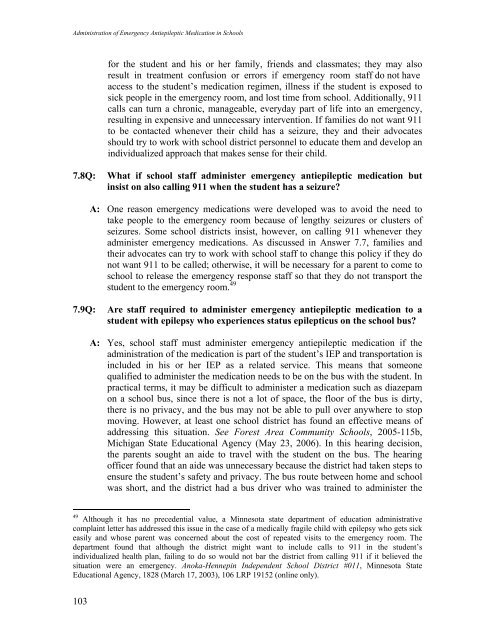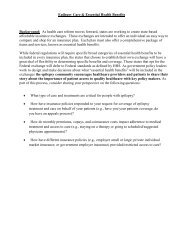Legal Rights of Children with Epilepsy in School & Child Care
Legal Rights of Children with Epilepsy in School & Child Care
Legal Rights of Children with Epilepsy in School & Child Care
You also want an ePaper? Increase the reach of your titles
YUMPU automatically turns print PDFs into web optimized ePapers that Google loves.
Adm<strong>in</strong>istration <strong>of</strong> Emergency Antiepileptic Medication <strong>in</strong> <strong>School</strong>s<br />
for the student and his or her family, friends and classmates; they may also<br />
result <strong>in</strong> treatment confusion or errors if emergency room staff do not have<br />
access to the student’s medication regimen, illness if the student is exposed to<br />
sick people <strong>in</strong> the emergency room, and lost time from school. Additionally, 911<br />
calls can turn a chronic, manageable, everyday part <strong>of</strong> life <strong>in</strong>to an emergency,<br />
result<strong>in</strong>g <strong>in</strong> expensive and unnecessary <strong>in</strong>tervention. If families do not want 911<br />
to be contacted whenever their child has a seizure, they and their advocates<br />
should try to work <strong>with</strong> school district personnel to educate them and develop an<br />
<strong>in</strong>dividualized approach that makes sense for their child.<br />
7.8Q: What if school staff adm<strong>in</strong>ister emergency antiepileptic medication but<br />
<strong>in</strong>sist on also call<strong>in</strong>g 911 when the student has a seizure?<br />
A: One reason emergency medications were developed was to avoid the need to<br />
take people to the emergency room because <strong>of</strong> lengthy seizures or clusters <strong>of</strong><br />
seizures. Some school districts <strong>in</strong>sist, however, on call<strong>in</strong>g 911 whenever they<br />
adm<strong>in</strong>ister emergency medications. As discussed <strong>in</strong> Answer 7.7, families and<br />
their advocates can try to work <strong>with</strong> school staff to change this policy if they do<br />
not want 911 to be called; otherwise, it will be necessary for a parent to come to<br />
school to release the emergency response staff so that they do not transport the<br />
student to the emergency room. 49<br />
7.9Q: Are staff required to adm<strong>in</strong>ister emergency antiepileptic medication to a<br />
student <strong>with</strong> epilepsy who experiences status epilepticus on the school bus?<br />
A: Yes, school staff must adm<strong>in</strong>ister emergency antiepileptic medication if the<br />
adm<strong>in</strong>istration <strong>of</strong> the medication is part <strong>of</strong> the student’s IEP and transportation is<br />
<strong>in</strong>cluded <strong>in</strong> his or her IEP as a related service. This means that someone<br />
qualified to adm<strong>in</strong>ister the medication needs to be on the bus <strong>with</strong> the student. In<br />
practical terms, it may be difficult to adm<strong>in</strong>ister a medication such as diazepam<br />
on a school bus, s<strong>in</strong>ce there is not a lot <strong>of</strong> space, the floor <strong>of</strong> the bus is dirty,<br />
there is no privacy, and the bus may not be able to pull over anywhere to stop<br />
mov<strong>in</strong>g. However, at least one school district has found an effective means <strong>of</strong><br />
address<strong>in</strong>g this situation. See Forest Area Community <strong>School</strong>s, 2005-115b,<br />
Michigan State Educational Agency (May 23, 2006). In this hear<strong>in</strong>g decision,<br />
the parents sought an aide to travel <strong>with</strong> the student on the bus. The hear<strong>in</strong>g<br />
<strong>of</strong>ficer found that an aide was unnecessary because the district had taken steps to<br />
ensure the student’s safety and privacy. The bus route between home and school<br />
was short, and the district had a bus driver who was tra<strong>in</strong>ed to adm<strong>in</strong>ister the<br />
49 Although it has no precedential value, a M<strong>in</strong>nesota state department <strong>of</strong> education adm<strong>in</strong>istrative<br />
compla<strong>in</strong>t letter has addressed this issue <strong>in</strong> the case <strong>of</strong> a medically fragile child <strong>with</strong> epilepsy who gets sick<br />
easily and whose parent was concerned about the cost <strong>of</strong> repeated visits to the emergency room. The<br />
department found that although the district might want to <strong>in</strong>clude calls to 911 <strong>in</strong> the student’s<br />
<strong>in</strong>dividualized health plan, fail<strong>in</strong>g to do so would not bar the district from call<strong>in</strong>g 911 if it believed the<br />
situation were an emergency. Anoka-Hennep<strong>in</strong> Independent <strong>School</strong> District #011, M<strong>in</strong>nesota State<br />
Educational Agency, 1828 (March 17, 2003), 106 LRP 19152 (onl<strong>in</strong>e only).<br />
103








